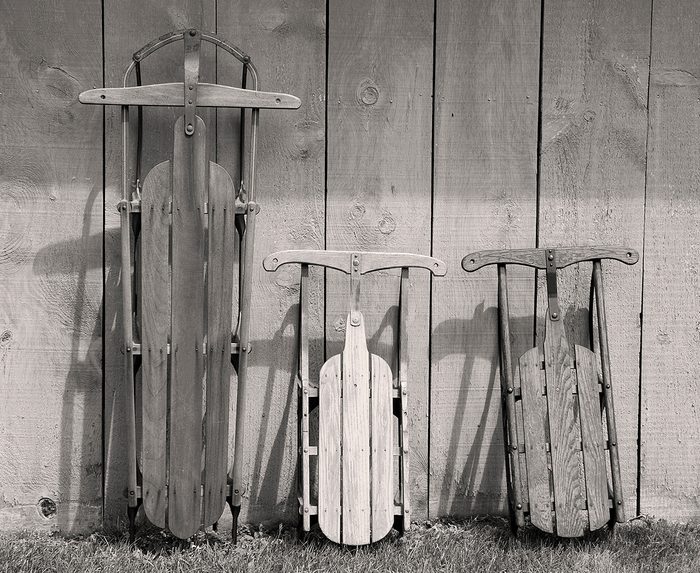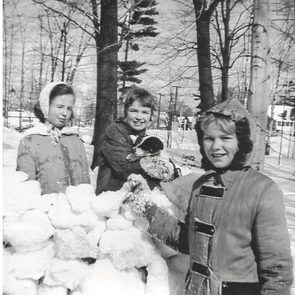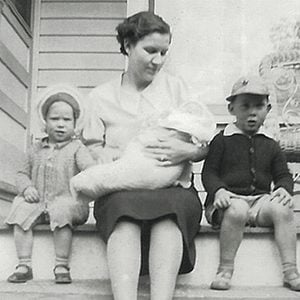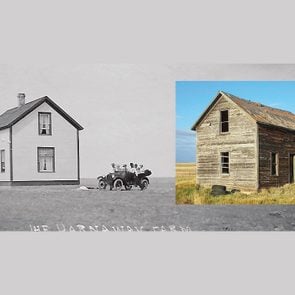Happy Memories of Sledding in the ’40s

Recalling the fun and adventure of childhood winters in Holland, Manitoba.
Holland, Manitoba, in the mid-1940s is where my story originates.
In winter, southern Manitoba received a reasonable amount of snow and, once it arrived, it usually stayed until spring. In those days, snow was left where it fell except for storefront steps and sidewalks near some homes’ entryways. The main street in Holland, called Broadway, had a gentle slope for about a block-and-a-half, stretching south of the Stewart Avenue intersection, which was named after my grandfather, and north beyond the intersection with S. Railway Avenue. For the most part, it was dimly lit by electric street lamps.
When snow fell, it was soon packed down by cars, trucks, horse-drawn sleighs or foot traffic. In town, Saturday night was the busiest of the week. Like many other small towns on the Prairies in those days, stores stayed open late on Saturday night. Farm families would come to town to get the mail, shop, have a beer or two, take in a movie or just visit.
In winter, they might curl a game or two or let the kids have a skate at the rink. All other weekday nights had very little traffic; as the saying goes, come 5 p.m. the streets were rolled up. This permitted the town youngsters to tote their sleighs and slide down main street, which with its reasonably good slope, was ideal for sledding.
Spirited Hijinks
Most evenings after supper—except Saturday night—many of us would migrate to the top of Broadway with our sleighs. Sometimes we would sit on the sleigh while another friend would give us a hefty running push. Other times we would take the sleigh in hand, dash forward, then plop it down onto the hard snow surface and drop ourselves face-down on top of it. Frequently, a friend who didn’t have a sleigh of their own, or had to share one with a brother, might follow you as you dashed, and he, too, would plop down on top of you in a piggyback manner.
The sleigh I had was built with steel runners and a wooden crossbar handle to steer the sleigh, keeping it to the centre or the crown of the road. Or, we could also assist steering by dragging one toe off to the side onto the snowy road. We could also paddle with our outspread arms onto the road to maintain speed and increase distance. We would usually travel the full length of the run. Often we would have a friendly competition to see who could go the fastest and/or the farthest. To stop in the event that a car was coming down the road or through the intersection, we’d simply roll over onto the snow.
Other sleigh types were designed in a very shallow format with a tow rope and elongated hand holes cut into the wooden side runners; these wooden runners had a round steel rod, shaped to wrap tightly into a groove routed around the ends and bottom of the side runners for a durable, more slippery running surface.
Down we would go, at the end of our run we would turn around and drag our sleighs back up the hill for another run. This went on for a couple of hours—the number of sledders would dwindle the later it became. In winter, darkness fell at about 5 p.m., however, all Sunday afternoon and weekday evenings were fair game. We usually finished by about 7:30 at night.
One peculiar incident I recall involved little Lloydy Elder. The Elder boys had a very shallow sleigh that would accelerate swiftly. Lloydy headed down the hill at full speed with his head tucked down and both arms paddling, not looking where he was headed. Suddenly, a 1920s vintage car with a high clearance entered the scene but Lloydy just kept on going. He passed beneath the vehicle without noticing until he came out the other side, none the worse for wear. Had he raised his head only slightly he would have surely been injured or worse, run over! I don’t recall anyone ever getting hurt. I can’t remember my mother ever having to scold me for coming home late or having to send my older sister Helen over the two blocks to tell me to “get home.” We never really seemed to feel the cold or suffered from frostbite, but we must have, we were just too busy having fun to notice.
Our family moved from the little town of Holland to Lethbridge, Alberta, in August 1948 when I was almost 11. Although this curtailed most of my winter sledding, I still recall the great fun we all had back then.
Next, find out what Prairie life was like during the Great Depression.






